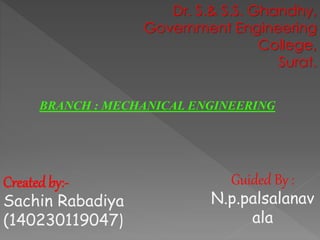Report
Share

Recommended
More Related Content
What's hot
What's hot (20)
Similar to Different type of scale copy
Similar to Different type of scale copy (20)
Triangulation survey (Basic Mine Surveying)_MI10412MI.pptx

Triangulation survey (Basic Mine Surveying)_MI10412MI.pptx
1-PHYSICAL QUANTITIES, UNITS & MEASUREMENT131029195248-phpapp01.ppt

1-PHYSICAL QUANTITIES, UNITS & MEASUREMENT131029195248-phpapp01.ppt
Different type of scale copy
- 1. Dr. S.& S.S. Ghandhy, Government Engineering College, Surat. BRANCH : MECHANICAL ENGINEERING Created by:- Sachin Rabadiya (140230119047) Guided By : N.p.palsalanav ala
- 3. scales1) Plain scale 2)Diagonal scale 3)Chord scale 4)Vernier scale
- 4. 1. Plain Sacle The plain scale is the most commonly used in maps.This scale is used to represent two successive units,such as units and tenths, metres,decimetres etc.
- 5. 2.Diagonal Scale Using a diagonal scale, one can measure three dimensions such as “units, tenths and hundredths”,” metres, decimeters and centimeters”, and so on. The diagonal scale is made on the principle of similar traiangles as shown in fig.
- 6. 3.Chord Scale A scale of chord is used to measure or to set off angles. It is marked either on a rectangular protractor or on an ordinary box wooden scale.
- 7. 4. Vernier Scale It consists of two approximating scales,one of them is fixed and is called the primary scale, the other is movable and is called vernier.
- 8. Direct Vernier Scale: If p=value of the smallest division of the primary scale v= value of the smallest division of the vernier scale n= number of division of the primary scale of a specified length n+1=number division of the vernier scale of same length
- 9. Least count = p n+1 = Value of one division of primary scale Number of division of vernier scale
- 10. Thank You